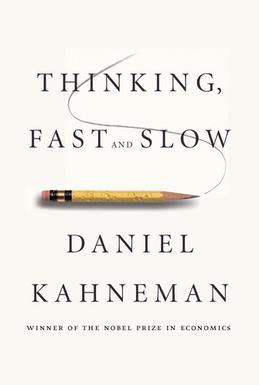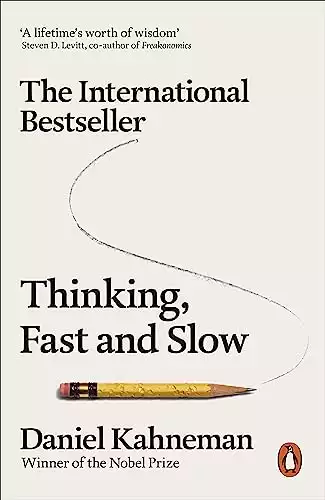Thinking, Fast and Slow Book Information
-
Book Title: Thinking, Fast and Slow
-
Author: Daniel Kahneman
-
Publication Date: October 2011
-
price: $517,00
-
Pages: 499
About the Author: Daniel Kahneman
Daniel Kahneman is an Israeli-American psychologist and economist renowned for his work on the psychology of judgment and decision-making, as well as behavioral economics. He was awarded the Nobel Memorial Prize in Economic Sciences in 2002 for his integration of psychological insights into economic science, particularly concerning human judgment and decision-making under uncertainty. His collaboration with Amos Tversky, tragically cut short by Tversky's death in 1996, formed the bedrock of much of the research presented in "Thinking, Fast and Slow." Kahneman's work has profoundly influenced fields ranging from economics and finance to medicine and political science.
Introduction to Thinking, Fast and Slow Book by Daniel Kahneman
Daniel Kahneman's Thinking, Fast and Slow is a groundbreaking exploration of the human mind, offering a deep dive into the two systems that shape how we think and make decisions. Published in 2011, the book brings together decades of Kahneman's influential research in behavioral economics and psychology. Through this lens, he uncovers the hidden cognitive biases and irrational patterns that influence our daily choices. This Thinking, Fast and Slow book review highlights its intellectually rigorous yet accessible nature, making it a transformative read that reshapes how we understand ourselves, our thinking, and the world around us.
Overview of the Thinking, Fast and Slow Book
"Thinking, Fast and Slow" isn't a typical self-help book. It's a deep dive into the mechanics of the mind, explaining how our brains work on two distinct levels: System 1 (fast, intuitive, and emotional) and System 2 (slow, deliberate, and logical). The book meticulously unpacks the interplay between these systems, revealing how they influence our judgments, decisions, and ultimately, our lives. Kahneman uses a wealth of experiments, anecdotes, and real-world examples to illustrate his points, making complex concepts accessible to a broad audience. He doesn't just tell us about our biases; he shows us how they operate in everyday situations, from buying groceries to making investment decisions. The book covers topics ranging from cognitive illusions and heuristics to prospect theory and loss aversion, providing a comprehensive overview of the field of behavioral economics.
Thinking, Fast and Slow Book Summary
Daniel Kahneman's "Thinking, Fast and Slow" explores the dual systems that drive the way we think. System 1 operates quickly and intuitively, relying on emotions and habits. System 2 is very slow and more intended. The book delves into cognitive biases, heuristics, and the impact these systems have on our judgments and decisions. Kahneman illustrates how our reliance on System 1 can lead to errors in reasoning, while System 2 often fails to correct these mistakes. He covers topics like loss aversion, framing effects, and the availability heuristic, providing practical insights into improving decision-making in various aspects of life. The book highlights the importance of understanding our cognitive limitations to make more rational choices.
Thinking, Fast and Slow Writing Style
Kahneman's writing is clear, engaging, and accessible, considering the complexity of the subject matter. He skillfully blends theoretical concepts with real-world examples and personal anecdotes, making the book both informative and relatable. He doesn't shy away from technical terms but always explains them in a way that non-experts can understand. The book is structured in a logical and organized manner, with each chapter building upon the previous one. Kahneman frequently uses thought experiments and quizzes to illustrate his points, encouraging readers to actively engage with the material. While the book is dense and requires careful attention, Kahneman's writing style makes it a manageable and enjoyable read.
Purpose of Reading Content
The purpose of reading "Thinking, Fast and Slow" is multifaceted. Firstly, it serves as a crucial educational tool, equipping readers with a deeper understanding of the cognitive processes that underpin human behavior. This knowledge is invaluable in fields ranging from economics and marketing to politics and personal relationships. Secondly, the book offers practical guidance on how to improve decision-making by mitigating the effects of cognitive biases. By becoming more aware of our irrational tendencies, we can make more informed and rational choices. Thirdly, "Thinking, Fast and Slow" provides a framework for understanding the complexities of the human mind, challenging our assumptions about rationality and free will. It encourages us to question our own beliefs and to be more open to alternative perspectives. Finally, reading this book can lead to greater self-awareness and a deeper appreciation for the intricacies of human nature. It prompts us to reflect on our own biases and to strive for more rational and thoughtful decision-making.
Ultimately, "Thinking, Fast and Slow" is a challenging but deeply rewarding read that offers profound insights into the workings of the human mind. It's a book that can change the way you think about thinking, and it's highly recommended for anyone interested in psychology, behavioral economics, or simply understanding themselves better.
Thinking, Fast and Slow Strengths and Weaknesses
Strengths:
- Comprehensive Coverage: "Thinking, Fast and Slow" provides a remarkably comprehensive overview of cognitive biases and heuristics.
- Rigorous Research: The book is grounded in decades of rigorous research conducted by Kahneman and Tversky.
- Engaging Style: Despite its academic subject matter, the book is written in an accessible and engaging style, making it appealing to a wide audience.
- Practical Applications: The insights offered in the book have practical applications in various fields, including business, finance, medicine, and public policy.
Weaknesses:
- Length and Complexity: The book is quite long and can be dense at times, requiring significant mental effort to fully grasp all the concepts.
- Overlapping Concepts: Some of the biases discussed overlap and can be difficult to distinguish from one another.
- Replicability Concerns: Some of the original studies cited in the book have faced challenges regarding replicability in recent years, raising questions about the robustness of some of the findings.
- Oversimplification: The System 1 and System 2 framework, while helpful, can be an oversimplification of the complexities of human cognition.
Key Quotes
"A reliable way to make people believe in falsehoods is frequent repetition, because familiarity is not easily distinguished from truth."
This quote is particularly relevant in the age of financial misinformation and market rumors.
"The illusion that we understand the past fosters overconfidence in our ability to predict the future."
A crucial reminder for investors and analysts who may overestimate their ability to forecast market trends.
Comparison with Similar Books
"Thinking, Fast and Slow" stands out in its depth and breadth, but it's worth considering how it compares to other popular books on similar topics:
- Predictably Irrational" by Dan Ariely: While Ariely's book focuses more on behavioral economics and the irrationality of everyday decisions, "Thinking, Fast and Slow" provides a more comprehensive theoretical framework for understanding the underlying cognitive mechanisms that drive these irrationalities. Ariely's book is more anecdotal and easier to read, while Kahneman's is more scientifically rigorous.
- "Nudge" by Richard Thaler and Cass Sunstein: "Nudge" investigates how people's decisions can be influenced by little adjustments to the way options are presented. While "Thinking, Fast and Slow" explains the cognitive biases that make nudging effective, "Nudge" focuses on the practical application of these insights in designing choice architectures.
Conclusion
"Thinking, Fast and Slow" is a challenging but ultimately rewarding read. It's a book that demands careful attention and reflection, but the insights it offers are transformative. By understanding the biases and heuristics that shape our thinking, we can become more aware of our own cognitive limitations and make more informed and rational decisions. While some of the original research has faced scrutiny in recent years, the core concepts of the book remain highly relevant and valuable. "Thinking, Fast and Slow" is not just a book to read; it's a book to study, to contemplate, and to apply to our everyday lives.





